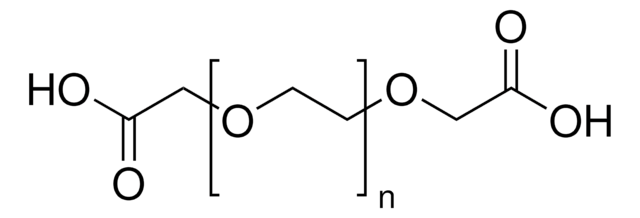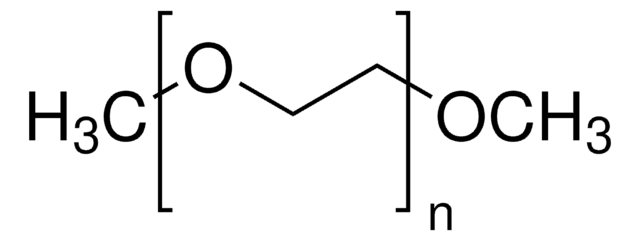推薦產品
產品名稱
聚乙二醇二羧酸, average Mn 250
形狀
viscous liquid
品質等級
分子量
average Mn 250
反應適用性
reagent type: cross-linking reagent
reactivity: amine reactive
折射率
n20/D 1.454
密度
1.302 g/mL at 25 °C
Ω-end
carboxylic acid
α-end
carboxylic acid
聚合物結構
shape: linear
functionality: homobifunctional
SMILES 字串
OCCO.OCC(O)=O
InChI
1S/C2H4O3.C2H6O2/c3-1-2(4)5;3-1-2-4/h3H,1H2,(H,4,5);3-4H,1-2H2
InChI 密鑰
SZUIEBOFAKRNDS-UHFFFAOYSA-N
尋找類似的產品? 前往 產品比較指南
一般說明
應用
儲存類別代碼
10 - Combustible liquids
水污染物質分類(WGK)
WGK 1
閃點(°F)
572.0 °F - closed cup
閃點(°C)
300 °C - closed cup
個人防護裝備
Faceshields, Gloves, Goggles, type ABEK (EN14387) respirator filter
客戶也查看了
文章
Progress in biotechnology fields such as tissue engineering and drug delivery is accompanied by an increasing demand for diverse functional biomaterials. One class of biomaterials that has been the subject of intense research interest is hydrogels, because they closely mimic the natural environment of cells, both chemically and physically and therefore can be used as support to grow cells. This article specifically discusses poly(ethylene glycol) (PEG) hydrogels, which are good for biological applications because they do not generally elicit an immune response. PEGs offer a readily available, easy to modify polymer for widespread use in hydrogel fabrication, including 2D and 3D scaffold for tissue culture. The degradable linkages also enable a variety of applications for release of therapeutic agents.
Devising biomaterial scaffolds that are capable of recapitulating critical aspects of the complex extracellular nature of living tissues in a threedimensional (3D) fashion is a challenging requirement in the field of tissue engineering and regenerative medicine.
我們的科學家團隊在所有研究領域都有豐富的經驗,包括生命科學、材料科學、化學合成、色譜、分析等.
聯絡技術服務










![2-[2-(2-甲氧基乙氧基)乙氧基]乙酸 technical grade](/deepweb/assets/sigmaaldrich/product/structures/335/694/b58c539b-141f-4ab2-98d9-5f46c748490b/640/b58c539b-141f-4ab2-98d9-5f46c748490b.png)
